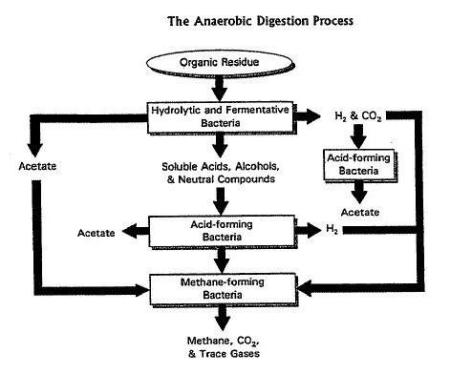Biogas is formed solely through the activity of bacteria, unlike composting in which fungi and lower creatures are also involved in the degradation process. Microbial growth and biogas production are very slow at ambient temperatures. They tend to occur naturally wherever high concentrations of wet organic matter accumulate in the absence of dissolved oxygen, most commonly in the bottom sediments of lakes and ponds, in swamps, peat bogs, intestines of animals, and in the anaerobic interiors of landfill sites.
The overall process of anaerobic digestion (AD) occurs through the symbiotic action of a complex bacteria consortium as show in diagram. Hydrolytic microorganisms, including common food spoilage bacteria, break down complex organic wastes. These subunits are then fermented into short-chain fatty acids, carbon dioxide, and hydrogen gases.

Syntrophic microorganisms then convert the complex mixture of short-chain fatty acids to acetic acid with the release of more carbon dioxide, and hydrogen gases. Finally, methanogenesis produces biogas from the acetic acid, hydrogen and carbon dioxide. Biogas is a mixture of methane, carbon dioxide, and numerous trace elements. According to some, the two key biological issues are determining the most favorable conditions for each process stage and how non-optimal circumstances affect each stage as a whole, and the governing role of hydrogen generation and consumption.
Tags: anaerobic digestion, anaerobic digestion process, biogas, floating tank covers, gas collection covers, gas collection floating covers, pond covers
Leave a comment